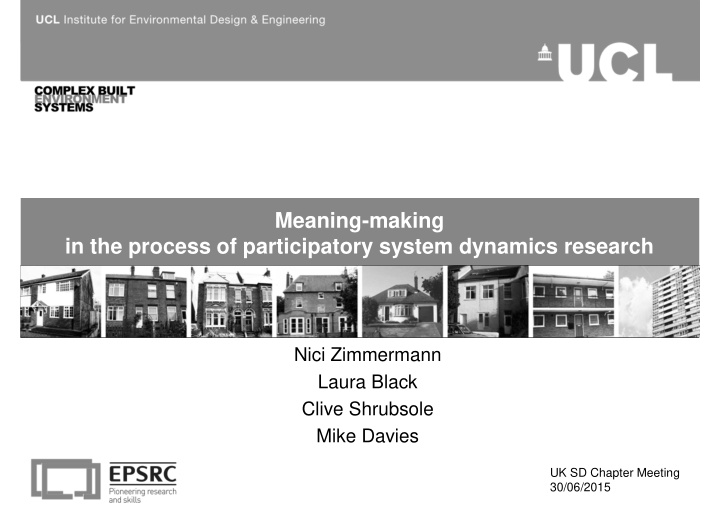



Meaning-making in the process of participatory system dynamics research Nici Zimmermann Laura Black Clive Shrubsole Mike Davies UK SD Chapter Meeting 30/06/2015
Issue • Achieving change – people’s actions, – their decision-making, – social interactions and – cognition. • Bounded rationality – Represented in model structure – In modelling process 2
‚Solution’: Participatory SD • Deals with bouded rationality in modelling process – Model quality – Changing participants’ thinking • Scripts = best practices • But where is the theory? – Planned behaviour (Ajzen 1991) – Boundary objects (Black 2013) 3
Mead‘s theory of socially construction meaning + Lave’s (1988) theory of situated cognition Mead’s Participatory process meaning-making meaning-making Gesturing Expressing experiential knowledge (Relational) Abstracting from experiential knowledge, Naming generalising by vocalising concepts and dependencies (Shared) Modifying shared representations, exploring Acting consequences of proposed dependencies, testing abstractions Iterating Re-representing verbally or graphically or via simulation 4
Mead‘s theory of socially construction meaning + Lave’s (1988) theory of situated cognition 5
6
Application to an empirical case Integrated decision-making about Housing, Energy and Wellbeing (HEW)
Our starting point • We know from history that single focus policies lead to ‘unintended’ effects 1920 USA High rise housing policy Australian Energy National Prohibition of the 1960s Efficient Homes Package • What will be the overall impact of polices aimed at reducing the energy demand and carbon emissions of dwellings? 8
Criteria for assessing policies 1. carbon emissions from housing 2. community social connection 3. fuel poverty 4. housing adaptation to climate change 5. housing affordability 6. mental and emotional wellbeing 7. physical wellbeing / health 8. social and income equity 9. policy coherence 9
Themes from the interviews 10
Application to an empirical case Integrated decision-making about Housing, Energy and Wellbeing (HEW) • Interviews • CLDs • Workshop 1 – Improve CLDs, select criteria • Workshop 2 – Mentally simulate • Workshop 3 – Multi-criteria decision analysis Elicitate problem Simulate Green Deal 11
Gesturing, naming, acting and iterating in the project case Mead’s Project case Green Deal meaning- making Gesturing Individual contributions in Few interviews interviews Many in-group contributions to explain the reference mode (Relational) Suggesting improvements to Facilitator’s re-phrasing of Naming CLDs in small groups contributions and unfolding model (Shared) Adapting CLDs Simulation cockpit (not used) Acting Using CLDs to estimate 3 major model runs (mentally simulate) outcomes Discussion of model boundary Iterating CLDs presented at 3 Iterations in explaining the reference workshops mode 12
13
Conclusion • Gesturing process is experience-broadening element in participatory processes • Naming not how they share exactly the same experience, but how they or their contributions are important for one another (Black, 2013; Black et al., 2014). • This allows them to act in a shared way and to iteratively explore the consequences of their proposed interdependencies. 14
Conclusion Practical implications • Story-telling • Learning environments Mental model alignment consensus, commitment and system • change (Rouwette et al., 2009) Future research • Diverse participatory settings • Rigorous exploration of relation to scripts • Individual and group outcomes 15
Your thoughts are welcome n.zimmermann [at] ucl.ac.uk 16
Recommend
More recommend